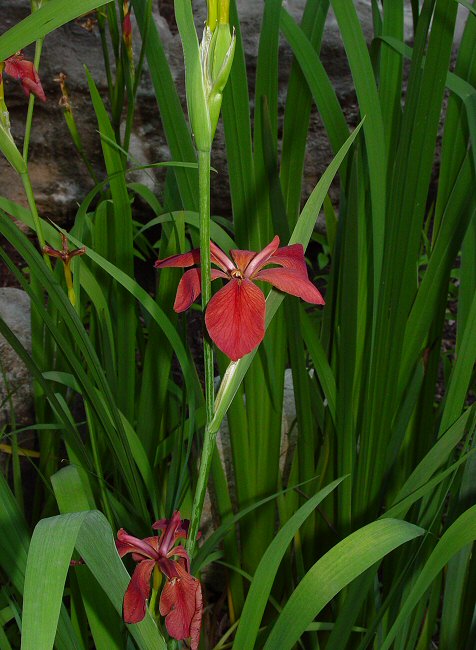Iris fulva Ker Gawl.
Copper Iris

Native
CC = 9
CW = -5
MOC = 8
© DETenaglia
Iris fulva Ker Gawl.Copper Iris | |
 |
Native CC = 9 CW = -5 MOC = 8 |
© DETenaglia |
|
Family - Iridaceae Habit - Rhizomatous perennial forb. Rhizomes lacking conspicuously thickened areas. Stems - Arching to erect, to 90 cm, usually somewhat longer than the leaves.
Leaves - Basal and 2-ranked on the aerial stems, 40-90 cm long, 15-25 mm wide, arching or nodding, flat. Inflorescences - Clusters of flowers terminal and axillary, each with 1-4 flowers, the spathelike bracts unequal, 3-8 cm long, herbaceous, green.
Flowers - Sepals 4.5-5.5 cm long, widely spreading or arching downward, obovate, glabrous, with 1-3 prominent, longitudinal veins, orange, copper-colored, or reddish brown, often with a lighter, yellow area near the base. Petals about as long as but narrower than the sepals, erect, orange, copper-colored, or reddish brown.
Fruits - Capsules 4.5-8.0 cm long, oblongelliptic in outline, 6-angled, with a single rib at each angle.
Flowering - April - June. Habitat - Swamps, bottomland forests, ditches, pond margins, sloughs, frequently in shallow water. Origin - Native to the U.S. Lookalikes - None close. Other info. - This attractive species can be found in a few counties in the bootheel of Missouri. It is a relatively uncommon plant, with a global distribution mostly confined to 6 states ranging from Missouri and Illinois southward. It is an easily identifiable species because of its general habit and copper-colored flowers. When lacking open flowers, it can be distinguished from I. virginica, with which it sometimes grows, by its shorter spathelike bracts. Photographs taken in Columbia, MO., 5-19-04 (DETenaglia); also at Poplar Bluff Conservation Area, Butler County, MO, 5-15-2016 (SRTurner). Fruit photo 9-26-2020 (KBildner). |